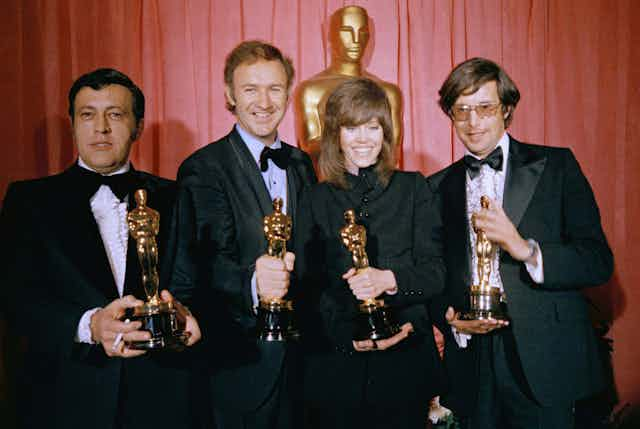In 1972, American cinema was ablaze with the energy of what later came to be called “The New Hollywood”. This was a group of film directors who were bringing a radical kind of cinema to the movie mainstream – movies with big budgets, edgy content and transgressive politics, all for a mass audience.
A few of them – Francis Ford Coppola, Peter Bogdanovich, William Friedkin – even tried to start their own American arthouse studio in San Francisco in the early 70s, making their movies far away from the studio executives.
With the audacity of relative youth on their side, they wanted to bring down the old system and remake Hollywood.
Foremost among these directors was a young Friedkin, who burst onto the Hollywood scene with his searing police drama, The French Connection. Released in 1971, the film galvanised audiences, changed the landscape of Hollywood genre realism, and took home five Oscars – including Best Picture.
I have a giant poster (a 1971 original) of The French Connection on my office wall. Apart from the gorgeous poster art, it’s a reminder to me of what that era of visionary cinema achieved in so short a period of time.
But Friedkin was also that something extra special, even among the Young Turks of the New Hollywood. He remained an unknown quantity, even while enjoying mainstream box office success. The prolific director has died at 87, just one month before his now final film is set to premiere at the Venice International Film Festival.
Read more: From the Moscow stage to Monroe and De Niro: how the Method defined 20th-century acting
Enduring artistic fascination
The stark realism of The French Connection shouldn’t have worked with the police procedural. Friedkin plays the thriller like something lifted from the French New Wave, say Jean-Pierre Melville’s glorious Le Cercle Rouge of 1970.
The French Connection was followed by perhaps the most notorious film of the Hollywood 1970s: The Exorcist (1973). The stories told about the film’s gargantuan run in Hollywood cinema chains are legendary: audiences running from theatres unable to stomach the content, screaming about the intensity of images of good and evil.
The Exorcist remains the apotheosis of the Christian horror, imitated a thousand times across the decades that followed. On its original release, the film took more than US$190 million on a US$11 million budget, cementing Friedkin’s place in the New Hollywood pantheon of visionary filmmakers.
Whereas Spielberg, Coppola and Scorsese found their niche in the mainstream Hollywood industry, Friedkin remained the enfant terrible and something of an outsider.
Alongside other directors such as Brian De Palma and his longtime friend Bogdanovich, Friedkin assured audiences Hollywood would not lose its tenuous grip on arthouse, experimental genre cinema.
Friedkin’s style was routinely unconventional. His material pushed the boundaries of the classical Hollywood system, traversing that line between mainstream and independence.
Like so many of the New Hollywood auteurs, Friedkin’s output after the 1980 masterpiece, Cruising, is patchy.
There were misses, such as The Guardian (1990) and Rules of Engagement (2000), and Friedkin shows his discomfort with Hollywood’s aesthetic and political constraint in the erotic thriller, Jade (1995).
But there many works from the last 40 years of enduring artistic fascination: the synth-oozing To Live and Die in LA (1985), which sets the template for Michael Mann’s Collateral (2004); Jade, Friedkin’s 1995 attempt to outdo Paul Verhoeven’s Basic Instinct (1992), a perverse pleasure precisely for its manic unevenness; and 2011’s stylised, hyper-violent domestic drama, Killer Joe.
My personal top five
I want to close this reflection with my William Friedkin top five, which I’ll be revisiting across the next week:
5. To Live and Die in LA (1985)
If The French Connection is the epitome of the New York Crime film, To Live and Die in LA is pure Los Angeles. It’s gritty, yes, and violent; but the film exudes cool, and in spite of its relative obscurity, was a major influence on a new generation of genre filmmakers.
4. Sorcerer (1977)
Many commentators on Friedkin’s career regard The Sorcerer as Friedkin’s last great auteur film. Of course, that’s not my opinion (see below). But it is true to say that Sorcerer (a remake of sorts of Henri-Georges Clouzot’s wonderful Wages of Fear from 1953) remains a stunningly experimental film in Hollywood of the late 1970s.
It tanked at the box office (opening a month after Star Wars!) and cast Friedkin as an unreliable director.
3. Cruising (1980)
Has Cruising – a film about a serial killer within New York’s homosexual subcultural community - been cancelled? I don’t know. I so desperately hope not.
What a stunning thriller in the tradition of the realist urban cinema, setting the scene for one of Al Pacino’s best and most unhinged performances. It first appeared with an X-rating and a mess of notoriety. It remains a brilliant film of this era.
2. The Exorcist (1973)
Simply put, the milestone that brought one of the most distinctive artistic visions to a classical possession genre story.
Adapted from William Peter Blatty’s novel (its own cultural phenomenon of the early 70s), Friedkin demonstrates the way in which audio-visual form can surpass its source material. Not for the squeamish!
1. The French Connection (1971)
Even if this film was one sequence – the car/subway chase through New York’s gritty underpasses – it would be a masterpiece. This is glorious action montage before the excesses of digital post-production hijinks. The film oozes a place and time unlike any other film shot in New York in the 1970s.
One of the best films ever made by a Hollywood studio.

